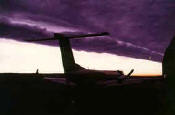|

The science of
meteorology, with all its knowledge, technical equipment
(including super computers) and experience, should be able
to pinpoint mountain turbulence. Let’s face it. Predicting
mountain turbulence is an inexact science. Meteorologists
have established guidelines and they actually do a good job
forecasting for large areas. But the fact remains, the exact
location and severity of disturbed air cannot be foretold.

Turbulence producer - giant thunderstorm
over the Front Range of Colorado
Turbulence
is not limited to mountainous regions and its classification
is the same for all areas where you can fly.
-
Convective turbulence
(thermals) is caused by vertical currents of air rising
from differential surface heating, producing updrafts
and downdrafts.
-
Mechanical turbulence
occurs when an obstruction to the wind impedes the
normal flow, setting up eddy currents on the leeward
side. Operating in the mountains exposes you to a
greater intensity of mechanical turbulence because the
obstructions (mountains) are bigger.
-
Wind shear
arises from frontal zones, sea breeze fronts,
thunderstorms and downburst cells.
-
Clear air turbulence
(CAT)
can occur at any altitude due to convective currents,
obstruction to wind flow, wind shear or any combination
of these.
An
understanding of turbulence and maneuvering speed is
important because airplanes operated at a speed greater than
the turbulent air penetration speed or maneuvering
speed, in moderate or greater turbulence, risk
structural failure.
Mountain
pilots are often exposed to more and usually greater
intensity mechanical turbulence than their flatland
counterparts, because the obstructions causing the
turbulence are larger.
Mountain pilots are
also at the mercy of mountain wave turbulence (wind shear).
The majority of mountain wave phenomena produces light to
moderate turbulence, but some waves produce severe or
greater turbulence.

Weather may be
fickle, changing at will; whereas, engineering is nearly an
exact science that allows engineers to predict the amount of
stress necessary to cause the structural failure of an
airplane.
An airplane’s
strength is basically measured by load factor, that is, the
total load the wings and tail are capable of carrying
without distortion, permanent damage or structural failure.
Load factor is the actual load on the wings divided by the
weight of the airplane. In straight-and-level flight the
wings support a weight equal to the weight of the airplane
and its contents, one g load factor.
The normal category airplane is generally
stressed for a positive limit load factor of 3.8 Gs, a
negative limit load of –1.52 Gs, and a 50-percent safety
factor that is added to the positive limit load resulting in
+5.7 Gs for the ultimate load factor.
Regulations
for the certification of the normal category airplane
require that it be able to withstand a derived gust velocity
of 30 feet per second (fps) at maximum level flight speed
and normal-rated power.
Lenticulars with rotor turbulence near
Lake Tahoe.
 Moderate
turbulence is classified as a derived gust velocity of 20-35
fps. This means anytime you encounter moderate or greater
turbulence, you must, for safety sake, slow to maneuvering
speed. Moderate
turbulence is classified as a derived gust velocity of 20-35
fps. This means anytime you encounter moderate or greater
turbulence, you must, for safety sake, slow to maneuvering
speed.
When operating
at a speed greater than maneuvering speed vertical gusts can
cause a sudden increase in the angle of attack. This results
in large wing loads that are resisted by the inertia of the
airplane. The structure is not designed to withstand this
load and may become permanently deformed or worse, it may
fail. When operating at or less than maneuver speed, the
airplane will stall before breaking. Gusts are momentary
features, so the stall is a brief stall and normally does
not require pilot-initiated stall recovery.
Maneuvering
speed, abbreviated Va, is called the rough air speed.
It is defined as the maximum speed at which full abrupt
control deflection can be made without exceeding the design
load factor.
Some pilots
mistakenly believe it is proper to fly at the ultimate load
factor. The ultimate load factor is designed to compensate
for vagaries in materials,
workmanship,
and age of the airplane. The structure is required to
support ultimate loads without failure for at least three
seconds (FAR § 23.305 Strength and deformation).
Maneuvering
speed is a value of 1.9 Vs. It changes with a change in
gross weight; decreasing as the weight decreases.
Turbulence producer – lenticular clouds
and rotor
turbulence (KIAD - Dulles International,
Washington, D.C.
Pilots notice
that a heavily loaded airplane rides smoother in turbulent
air. They perceive this as an indication that the airplane
should be loaded to its maximum whenever turbulence is
expected. This is a bad assumption.
Consider an
airplane that has a maximum allowable gross weight of 3,000
pounds. If it encounters a +30 fps gust that results in an
additional 2-g load factor, the airplane experiences a total
of 3 Gs load factor. Multiply the 3-g load factor by 3,000
pounds and the wings are supporting 9,000 pounds.
Assume the
airplane is loaded to 1,500 pounds and that it is subjected
to the same gust. With half the inertia, the gust
acceleration is doubled, causing the airplane to experience
a 5-g load factor (4-g force plus 1-g level flight).
Multiply 1,500 pounds by 5 gs and the wings are supporting
7,500 pounds.
The lightly
loaded airplane is subjected to 1,500 pounds less load when
encountering the same gust. Even though the heavy airplane
realizes less load factor, it incurs more strain. The pilot
recognizes load factor; the airplane recognizes load.
The diligent
pilot who adheres strictly to the maneuvering speed when in
turbulence can experience an unexpected problem.
Maneuvering
speed is based on multiplying the power off stall
speed (VS1) by the square root of the limit
positive maneuvering load factor, n, used in design
(usually 3.8 Gs). For most normal category airplanes this is
1.949 VS. Most of the time an airplane is flown
with the power on. The power on stall speed is
significantly less than with the power off. When the stall
speed decreases, maneuvering speed decreases.
A pilot flying
across a mountain range may encounter the rotor cloud (roll,
rotor, arcus) that subjects the airplane to a gust from the
front. This will increase the headwind shear and has the
effect of increasing the airspeed beyond the value of
maneuvering speed.
 The
reduced stall speed (power on) and increasing airspeed
(shear) may cause the wing loading to exceed the limit load
factor. The
reduced stall speed (power on) and increasing airspeed
(shear) may cause the wing loading to exceed the limit load
factor.
My
recommendation, when required to slow to maneuvering speed,
is to use the value of 1.7 Vs instead of the 1.9 Vs allowed
by regulation. Further, if the airplane doesn’t have an
owner’s manual or pilot’s operating handbook, determine the
reduced weight maneuvering speed in the following manner:
The primary
source of information concerning turbulence is pilot
reports. Many of these reports are exaggerated because of
different reporting criteria used by the pilot and the
pilot’s judgment, usually based upon the amount of time
spent in the turbulence. Brief encounters with turbulence
are not likely to be considered significant. Turbulence
lasting several minutes or more will be considered
important.
Rotor turbulence, Aspen, Colorado
The primary source of information concerning
turbulence is pilot reports; however, these reports are
often grossly exaggerated.
A pilot's judgment of turbulence and its
severity is influenced by his experience level, the type of
aircraft being flown and the length of time he experiences
the turbulence. Brief encounters are not likely to be
considered significant, but turbulence lasting several
minutes or longer will be considered to the pilot.
-
Occasional means the
turbulence is occurring less than 1/3 of the time.
-
Intermittent is from
1/3 to 2/3 of the time.
-
Continuous is more than
2/3 of the time.
Turbulence is divided into four degrees of
intensity.
-
Light – The occupants
may be required to use seat belts, but objects in the
aircraft remain at rest.
-
Moderate – the
occupants require seat belts and are occasionally thrown
against the belt. Unsecured objects in the aircraft move
about.
-
Severe – the aircraft
may be momentarily out of control. Occupants are thrown
violently against the belt and back into the seat.
Objects not secured in the aircraft are tossed about.
-
Extreme – this is a
rarely encountered condition in which the aircraft is
violently tossed about and is practically impossible to
control. It may cause structural damage.
Fly above
cumulus clouds (if possible) to avoid convective turbulence.
If the air is too dry to form clouds, determine the base of
convective activity by subtracting the dew point from the
temperature in degrees Fahrenheit. Multiply this figure by
two. The result is the altitude, in hundreds of feet (add
two zeros to your answer), of the base of convective
activity above the ground. Fly 1,000 feet or so above this
altitude to avoid convective turbulence.
Destructive
mountain wave turbulence can be avoided by flying half again
as high as the mountain tops. This doesn’t mean when flying
over Colorado, with 54 peaks over 14,000 feet that you have
to fly at 21,000 feet. Subtract the surrounding terrain
elevation from the mountain top and use half this value
added to the mountain top.
 Slow
to maneuvering speed whenever moderate or greater turbulence
is experienced or expected. Visualize the cause and maneuver
to avoid the area. Slow
to maneuvering speed whenever moderate or greater turbulence
is experienced or expected. Visualize the cause and maneuver
to avoid the area.
Rotor cloud, Calgary, Alberta
|







